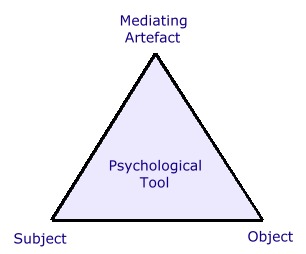Psychological Tools
"...by being included in the process of behaviour, the psychological tool alters the entire flow and structure of mental functions. It does this by determining the structure of a new instrumental act,..."
- L. S. Vygotsky, 1981

Near the beginning of the twentieth century, Russian psychologist Lev S. Vygotsky proposed his social cultural theory of learning and communication. In the diagram above, the subject represents either the creator or the viewer of cyberart. The object of activity represents the creation and/or appreciation of the cyberart itself, resulting with cyberart becoming a mediating artefact within the cyberspace environment.
Psychological tools are artefacts located in a socio-historical context that form an integral part of human action - in this case, the creation of cyberart or the experiencing of the cyberart within the cyberspace context. For Vygotsky, mediation with tools provides a medium to connect the external and the internal, the social and the individual. In sociocultural theory individuals and artefacts are comprehended as aggregates embedded within sociocultural activities. Artefacts are thus understood as extensions of the individual. People develop their tools (cyberart) at the same time as these tools influence the community in which they are used (cyberspace).
The humanistic tradition of looking at art, helps the viewer to perceive the symbolic meaning within the art form. During this process people perceive how individual artists interact with the viewer through the visual form given to the ideas embodied in the work. The artist is the source of these ideas. The work is the medium carrying the message. The viewer, receives and experiences the symbolic imagery inherent in the work to complete the communication cycle.
Communication through the visual arts is clearest when both artist and viewer share similar values, have compatible life experiences and develop interactive modes of attending to these experiences. This generally occurs within a specific culture or society where people's values and beliefs access their experiences and ways of viewing the world. The ability to 'read' a work of art results from the viewer comprehending a visual language that occurs in a social context and indicates that he or she has understood the questions raised by the artist in the process of creating the work of art.
Artists deliberately set out to communicate ideas to others using familiar symbols in order to be readily understood. In some instances, the individual insights of the artist are so penetrating and the arts form so strong that the work is appreciated generation after generation, and by more than one culture.
"We may therefore call art a delayed reaction, because there is always a fairly long period of time between its effect and its execution. This does not mean, however, that the effect of art is mysterious or mystical or that its explanation requires some new concepts different from those which the psychologist sets up when he analyzes common behavior. Art performs with our bodies and through our bodies. It is remarkable that scholars like Rutz and Sievers, who studied perceptual processes and not the effects of art, speak of the dependence of aesthetic perception on a specific muscular constitution of the body. Rutz was the first to suggest that any aesthetic effect must be associated with a definite type of muscular constitution" (Vygotsky, 1925).
If we regard art as an embellishment or ornament of life, such a view- point is admissible. However, it basically contradicts the psychological laws of art. Psychological investigation reveals that art is the supreme center of biological and social individual processes in society, that it is a method for finding an equilibrium between man and his world, in the most critical and important stages of his life. This view of course completely refutes the approach according to which art is an ornament, and thereby leads us to doubt the correctness of the above statement. Since the future has in store not only a rearrangement of mankind according to new principles, not only the organization of new social and economic processes, but also the "remolding of man," there seems hardly any doubt that the role of art will also change.
It is hard to imagine the role that art will play in this remolding of man. We do not know which existing but dormant forces in our organ- isms it will draw upon to form the new man. There is no question, however, that art will have a decisive voice in this process. Without new art there can be no new man. The possibilities of the future, for art as well as for life, are inscrutable and unpredictable. As Spinoza said, "That of which the body is capable has not yet been determined." (Vygotsky, 1925).
References
Chandler, S. (2001). Living and learning ideas II. http://www.msu.edu/~dwong/CEP900/LL2/SherriLL2.htm
Phillips, D. and Soltis, P. (1998). Perspectives on Learning. New York, N.Y.: Teachers College Press.
Smagorinsky, P. (n.d) The social construction of data: Methodological problems of investigating learning in the zone of proximal development. http://psych.hanover.edu/vygotsky/smagor.html
Vygotsky, L. S. (1925). Published in English - (1971). The psychology of art.Psikologiia Iskusstva
http://www.marxists.org/archive/vygotsky/works/1925/index.htm
Vygotsky, L. S. (1981). The instrumental method in psychology. In The concept of activity in Soviet psychology. ed. J. V. Wertsch. Armonk, N.Y.: M.E. Sharpe.
Wertsch, J. V. (1991). Voices of the mind: A sociocultural approach to mediated action. Cambridge, MA: Harvard University Press.
nursing-informatics.com - an initiative by:
June Kaminski, MSN PhD(c) © 2000 - 2023
|
 |
|

